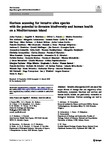Horizon scanning for invasive alien species with the potential to threaten biodiversity and human health on a Mediterranean island
| dc.contributor.author | Peyton, J | |
| dc.contributor.author | Martinou, AF | |
| dc.contributor.author | Pescott, OL | |
| dc.contributor.author | Demetriou, M | |
| dc.contributor.author | Adriaens, T | |
| dc.contributor.author | Arianoutsou, M | |
| dc.contributor.author | Bazos, I | |
| dc.contributor.author | Bean, CW | |
| dc.contributor.author | Booy, O | |
| dc.contributor.author | Botham, M | |
| dc.contributor.author | Britton, JR | |
| dc.contributor.author | Cervia, JL | |
| dc.contributor.author | Charilaou, P | |
| dc.contributor.author | Chartosia, N | |
| dc.contributor.author | Dean, HJ | |
| dc.contributor.author | Delipetrou, P | |
| dc.contributor.author | Dimitriou, AC | |
| dc.contributor.author | Dörflinger, G | |
| dc.contributor.author | Fawcett, J | |
| dc.contributor.author | Fyttis, G | |
| dc.contributor.author | Galanidis, A | |
| dc.contributor.author | Galil, B | |
| dc.contributor.author | Hadjikyriakou, T | |
| dc.contributor.author | Hadjistylli, M | |
| dc.contributor.author | Ieronymidou, C | |
| dc.contributor.author | Jimenez, C | |
| dc.contributor.author | Karachle, P | |
| dc.contributor.author | Kassinis, N | |
| dc.contributor.author | Kerametsidis, G | |
| dc.contributor.author | Kirschel, ANG | |
| dc.contributor.author | Kleitou, Periklis | |
| dc.contributor.author | Kleitou, D | |
| dc.contributor.author | Manolaki, P | |
| dc.contributor.author | Michailidis, N | |
| dc.contributor.author | Mountford, JO | |
| dc.contributor.author | Nikolaou, C | |
| dc.contributor.author | Papatheodoulou, A | |
| dc.contributor.author | Payiatas, G | |
| dc.contributor.author | Ribeiro, F | |
| dc.contributor.author | Rorke, SL | |
| dc.contributor.author | Samuel, Y | |
| dc.contributor.author | Savvides, P | |
| dc.contributor.author | Schafer, SM | |
| dc.contributor.author | Tarkan, AS | |
| dc.contributor.author | Silva-Rocha, I | |
| dc.contributor.author | Top, N | |
| dc.contributor.author | Tricarico, E | |
| dc.contributor.author | Turvey, K | |
| dc.contributor.author | Tziortzis, I | |
| dc.contributor.author | Tzirkalli, E | |
| dc.contributor.author | Verreycken, H | |
| dc.contributor.author | Winfield, IJ | |
| dc.contributor.author | Zenetos, A | |
| dc.contributor.author | Roy, HE | |
| dc.date.accessioned | 2019-04-23T08:52:24Z | |
| dc.date.available | 2019-04-23T08:52:24Z | |
| dc.date.issued | 2019-04-16 | |
| dc.identifier.issn | 1387-3547 | |
| dc.identifier.issn | 1573-1464 | |
| dc.identifier.uri | http://hdl.handle.net/10026.1/13725 | |
| dc.description.abstract |
Invasive alien species (IAS) are one of the major drivers of change that can negatively affect biodiversity, ecosystem functions and services and human health; islands are particularly vulnerable to biological invasions. Horizon scanning can lead to prioritisation of IAS to inform decision-making and action; its scale and scope can vary depending on the need. We focussed on IAS likely to arrive, establish and affect biodiversity and human health on the Mediterranean island of Cyprus. The scope of the horizon scanning was the entire island of Cyprus. We used a two-step consensus-building process in which experts reviewed and scored lists of alien species on their likelihood of arrival, establishment and potential to affect biodiversity, ecosystems and/or human health in the next 10 years. We reviewed 225 alien species, considered to be currently absent on Cyprus, across taxa and environments. We agreed upon 100 species that constituted very high, high or medium biodiversity risk, often arriving through multiple pathways of introduction. The remaining 125 species were ranked as low risk. The potential impacts on human health were documented for all 225 species; 82 species were considered to have a potentially negative impact on human health ranging from nuisance to disease transmission. The scope of the horizon scanning was the entire island of Cyprus, but the thematic groups also considered the relevance of the top 100 species to the Sovereign Base Areas of Cyprus, given their differing governance. This horizon scan provides the first systematic exercise to identify invasive alien species of potential concern to biodiversity and ecosystems but also human health within the Mediterranean region. The process and outcomes should provide other islands in the region and beyond with baseline data to improve IAS prioritisation and management. | |
| dc.format.extent | 2107-2125 | |
| dc.format.medium | Undetermined | |
| dc.language | en | |
| dc.language.iso | en | |
| dc.publisher | Springer (part of Springer Nature) | |
| dc.subject | Consensus approach | |
| dc.subject | Cyprus | |
| dc.subject | Levant | |
| dc.subject | Non-native species | |
| dc.subject | Pathways | |
| dc.subject | Prioritisation | |
| dc.title | Horizon scanning for invasive alien species with the potential to threaten biodiversity and human health on a Mediterranean island | |
| dc.type | journal-article | |
| dc.type | Journal Article | |
| plymouth.author-url | https://www.webofscience.com/api/gateway?GWVersion=2&SrcApp=PARTNER_APP&SrcAuth=LinksAMR&KeyUT=WOS:000467649500022&DestLinkType=FullRecord&DestApp=ALL_WOS&UsrCustomerID=11bb513d99f797142bcfeffcc58ea008 | |
| plymouth.issue | 6 | |
| plymouth.volume | 21 | |
| plymouth.publication-status | Published | |
| plymouth.journal | Biological Invasions | |
| dc.identifier.doi | 10.1007/s10530-019-01961-7 | |
| plymouth.organisational-group | /Plymouth | |
| plymouth.organisational-group | /Plymouth/Faculty of Science and Engineering | |
| plymouth.organisational-group | /Plymouth/Faculty of Science and Engineering/School of Biological and Marine Sciences | |
| plymouth.organisational-group | /Plymouth/Users by role | |
| plymouth.organisational-group | /Plymouth/Users by role/Academics | |
| dcterms.dateAccepted | 2019-03-11 | |
| dc.rights.embargodate | 2019-12-18 | |
| dc.identifier.eissn | 1573-1464 | |
| dc.rights.embargoperiod | Not known | |
| rioxxterms.versionofrecord | 10.1007/s10530-019-01961-7 | |
| rioxxterms.licenseref.uri | http://www.rioxx.net/licenses/all-rights-reserved | |
| rioxxterms.licenseref.startdate | 2019-04-16 | |
| rioxxterms.type | Journal Article/Review |


